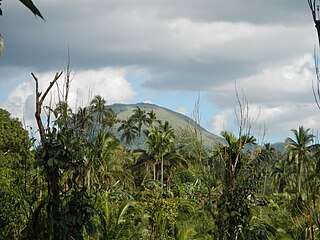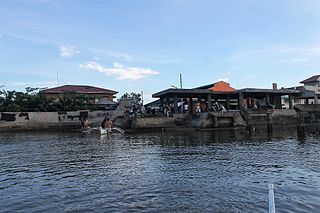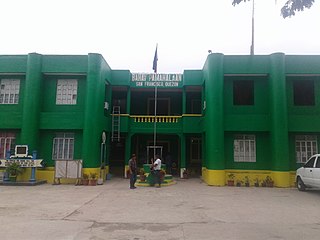
Mabitac, officially the Municipality of Mabitac, is a 5th class municipality in the province of Laguna, Philippines. According to the 2020 census, it has a population of 21,275 people.

Padre Burgos, officially the Municipality of Padre Burgos, is a 4th class municipality in the province of Quezon, Philippines. According to the 2020 census, it has a population of 23,488 people.

Victoria, officially the Municipality of Victoria, is a 4th class municipality in the province of Laguna, Philippines. According to the 2020 census, it has a population of 43,408 people.

Calauan, officially the Municipality of Calauan, is a 2nd class municipality in the province of Laguna, Philippines. The municipality has a land area of 25.25 square miles which constitutes 3.41% of Laguna's total area. According to the 2020 census, it has a population of 87,693 people.

Gumaca, officially the Municipality of Gumaca, is a 1st class municipality in the province of Quezon, Philippines. According to the 2020 census, it has a population of 71,942 people.

Amadeo, officially the Municipality of Amadeo, is a 4th class municipality in the province of Cavite, Philippines. According to the 2020 census, it has a population of 41,901 people.

Alabat, officially the Municipality of Alabat, is a 5th class municipality in the province of Quezon, Philippines. According to the 2020 census, it has a population of 15,936 people.

Dolores, officially the Municipality of Dolores, is a 4th class municipality in the province of Quezon, Philippines. According to the 2020 census, it has a population of 32,514 people.

General Luna, officially the Municipality of General Luna, is a 4th class municipality in the province of Quezon, Philippines. According to the 2020 census, it has a population of 24,804 people.

General Nakar, officially the Municipality of General Nakar, is a 1st class municipality in the province of Quezon, Philippines. According to the 2020 census, it has a population of 34,225 people. It is the largest municipality in the province of Quezon in terms of land area, occupying 1,343.75 kilometers (834.97 mi). It is accessible by land from Metro Manila, passing through Marcos Highway.

Lopez, officially the Municipality of Lopez, is a 1st class municipality in the province of Quezon, Philippines. According to the 2020 census, it has a population of 94,657 people.

Macalelon, officially the Municipality of Macalelon, is a 4th class municipality in the province of Quezon, Philippines. According to the 2020 census, it has a population of 27,312 people.

Patnanungan, officially the Municipality of Patnanungan, is a 5th class municipality in the province of Quezon, Philippines. According to the 2020 census, it has a population of 15,052 people.

Perez, officially the Municipality of Perez, is a 5th class municipality in the province of Quezon, Philippines. According to the 2020 census, it has a population of 12,767 people.

Plaridel, officially the Municipality of Plaridel, is a 5th class municipality in the province of Quezon, Philippines. According to the 2020 census, it has a population of 10,129 people.

San Andres, officially the Municipality of San Andres, is a 4th class municipality in the province of Quezon, Philippines. According to the 2020 census, it has a population of 37,454 people.

San Francisco, officially the Municipality of San Francisco, is a 2nd class municipality in the province of Quezon, Philippines. According to the 2020 census, it has a population of 62,097 people.

San Narciso, officially the Municipality of San Narciso, is a 3rd class municipality in the province of Quezon, Philippines. According to the 2020 census, it has a population of 51,058 people.

Tagkawayan, officially the Municipality of Tagkawayan, is a 1st class municipality in the province of Quezon, Philippines. According to the 2020 census, it has a population of 54,003 people.

Tiaong, officially the Municipality of Tiaong, is a first-class municipality in the province of Quezon, Philippines. According to the 2020 census, it has a population of 106,265 people.
























